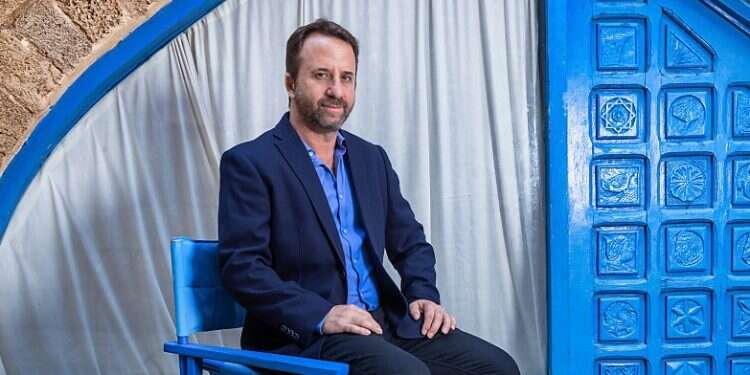Shachar Gafni is a successful developer known for his work with NASA and Intel. But he is also an independent researcher studying the Exodus from Egypt and has put forth a hypothesis that goes against the grain.
Q: You've often spoken about the use of digital tools in archaeology. Could you elaborate on that?
"Public archaeology is a global trend. It's about conducting research using the tools available online, which are mostly free of charge. It used to take an entire career of digging through archives to come across a significant find, but today Google Earth's satellite photos make it easy and quick, along with scanning antiquities maps in which Google has invested.
Follow Israel Hayom on Facebook, Twitter, and Instagram
"For instance, a researcher from Israel can study ancient Persian culture and virtually visit these sites without ever getting on a plane. Experts and aficionados can identify ancient buildings and walls under sand or grass. Besides the information tools available online, there are also tools for sharing information that lead to the establishment of learning and research communities."
Q: Could such amateur archaeology possibly lead to an irresponsible rewriting of history?
"We are living in the age of information, and at any given moment a traditional tool from the industrial age is giving way to new tools. I agree that in this age everyone can decide what the truth is for him. I also agree that there is a danger in fake news, but a greater danger is the phenomenon of echo chambers.
"Meaning, those same social media algorithms that show us more of the same [content matching our] opinion and prevent broader thinking. This is one of the underground factors that has been dividing our society for years, turning discourse more extreme. I believe that every need to verify information against fake news has a technological solution, and indeed there are already projects working in that direction, such as Fact Protocol."
Q: Doesn't technology that backs up facts – and powerful search engines and artificial intelligence – also challenge academic research?
"Google and its services are tools and scientists themselves are already leading the revolution these days, so we will see them create more and more collaborative community solutions for publishing articles and more use of artificial intelligence.
"As for my current findings – my predecessors used to go to the library, while I turned to Google and research databases available online. I even used artificial intelligence.
Q: So what is it that you found exactly?
"When I was 10 years old, my family and I met a historian – Avigdor Shachan, who theorized that when Israelites left Egypt they turned toward the West, that is they walked in the Sahara desert in Africa, and not in the Sinai Peninsula.
"This stayed with me and during the first coronavirus lockdown I delved deeper into the subject and discovered that in his book 'Bambara', researcher Joseph Eidelberg also put forward a hypothesis that said that the Israelites marched in Africa after leaving Egypt.
"Eidelberg also suggested that an oasis called Selima, located in northern Egypt to the West of the Nile is one of the stops the Israelites made on their journey, called 'Elim.'
"In an advanced internet search on the Selima Oasis, I found that it is a water source located on an ancient trade route between Egypt and Africa, known as the Darb al-Arbaʿīn, which translates to 'route 40.' I also came upon a map from 1533 and noticed a landmark on the map named Marah, [which was mentioned in Scripture as] station before Elim".
Q: Marah, where the water was said to have been bitter until Moses threw a log in, making it sweet.
"That's right. Another map from 1818 indicated the place, this time as 'Mour', and said that the water there was too bitter to drink. Not only that, the place lay along the same ancient trade route, and the next stop from north to south was Selima – and there the Torah says the water was fit for drinking.
"During my research, I learned that Flavius Josephus spoke of young Moses, who – being the prince of Egypt – led a daring military operation against the Kush in southern Egypt. His surprising move was to lead the army along the same road parallel to the Nile. That is, Moses knew the road. Moreover, the Torah says that Moses had a Kushite wife, and ancient Midrashim say that he indeed was connected to a Kushite queen from southern Egypt before he came to Midian."
Q: These are all fascinating, but how did you go from several minor details to the conclusion that the Israelites must have wandered in Africa?
"There are also ancient maps that show a place called Sukkoth on that same ancient trade route. Is this a coincidence? Although Scripture says that Sukkoth was the first stop, and here it is essentially the last stop, perhaps they set out toward Sukkoth."
Q: If the Israelites went south from Egypt, how could they have crossed the Red Sea?
"It is agreed upon by many researchers that the modern-day Red Sea is not the biblical Red Sea. Throughout history, they have tried to offer different interpretations. Eidelberg, and later Shachan, made an original and interesting claim that the miracle of the crossing of the Red Sea – and the drowning of Pharaoh's army – happened because of the Israelite's boldness and ability to improvise. He theorized that the Israelites sabotaged the dams that guarded the drainage basin of the Nile. The raising of the dam allowed the Israelites to pass, and its subsequent breach created a tremendous flood."
Q: If so, where exactly did this occur?
"I believe that the biblical Red Sea is located in Egypt, in a valley West of the Nile, known as the Faiyum Valley. In ancient times it was called 'Pi-yum', meaning 'the house of the sea', and indeed there is a lake in the valley whose waters are fed by the Nile through a canal that to this day the Egyptians call Al-Yosef, meaning the Joseph Canal.
"I came across a textbook in civil engineering that analyzed the canal and said that had the dams of the canal been breached, the damage would be enormous. Moreover, the engineer who authored the book said that the location seemed to him most suitable for the story of the crossing of the Red Sea to take place precisely because of this reason. I suppose my theory is the only one that has the approval of an engineer, a certified hydrologist. The map I found shows where the Israelites were trapped between the sea and Pharaoh's army."
Q: Another fascinating aspect of your theory is the claim that Mt. Sinai was actually a volcano.
"Eidelberg suggested a mountain named Emi Koussi in the Sahara, located west of Egypt and south of Libya. Why a volcano? The Song of Deborah says, 'The mountains melted in the presence of the Lord.' And Habakkuk says, 'And the everlasting mountains were shattered.' The Book of Exodus, Chapter 24 says, 'Like a consuming fire atop the mountain.' Deuteronomy, Chapter 4 says, 'And the mountain burned with fire up to the midst of the heavens.' And Moses saw the angel 'in a flame of fire from within the thorn bush.'
Q: One of the counterclaims, however, is that Emi Koussi has been extinct for millions of years.
"Yes. An advanced scan of the area found another mountain, further south, called Jabal Marra, located in Sudan. It is more fitting because it was active about 3,500 years ago, and its eruption was special. This mountain erupted in a so-called 'Plinian' fashion, which is when the smoke and fire form a tall column that can reach a height of 20 kilometers [12 miles], definitely something that can be seen from afar in the desert."
Q: And how did the Israelites return from Africa to Canaan then? Certainly not back via Egypt.
"No. My predecessors claimed that the Israelites marched to the south of the Red Sea and crossed on foot from Bab-el-Mandeb to present-day Yemen and Saudi Arabia, and from there marched north. I hypothesize that they crossed the sea in ships. I located an ancient seaport in the Eritrean region called Adulis, on which a Greek historian wrote that it was founded by slaves who escaped from Egypt.
"An adventurous traveler from a later period said that the head of the settlement was named – surprisingly – Moses. Moreover, in the Ki Tavo portion there are warnings of what would happen to the Israelites if they disobeyed God. There is a detailed list of calamities that would befall them, and one of them is 'And the Lord will bring you back to Egypt in ships.' Why mention the ships all of a sudden? These threats are mentioned to the Israelites while they are in the desert."
Q: Although the Exodus is one of the cornerstones of Judaism, no archeological find has been able to fully confirm or refute the account. As someone who comes from the field of high-tech, would you say technology can lead to the truth?
"Sure, but we must remember that the only archaeological find that confirms the existence of the House of David is one accidental inscription from Tel Dan. The only find that confirms the existence of the Israelites from around 1,200 BCE is an Egyptian inscription that describes a military campaign – the Merneptah Stele.
"That is why it is difficult to make an absolute determination based on what they did not find, and on the contrary – the rarity of the above-mentioned findings requires modesty and humility. The large amount of findings supporting the route of the Exodus from Egypt to Africa does not allow the likelihood of this to be ignored."
Subscribe to Israel Hayom's daily newsletter and never miss our top stories!
Q: The consensus among scientists is that the story of the Exodus is a myth. The majority do not support your theory and even call it pseudo-science.
"I have yet to meet someone who holds on to a certain opinion for years and gives it up easily. Moreover, many researchers are not familiar with the theory of Joseph Eidelberg and Avigdor Shachan.
"My findings offer a reasonable possibility for the path of the Israelites. I publish them on a website called lostexodus, and allow the public to help find additional clues.
"Furthermore, it is a bridge between the secular and the religious. I've had the opportunity to talk with many secular people, and it is unfortunate that many of them do not remember the stories of the Hebrew Bible. On Seder night, they hurry to get to the eating part and miss the story of the birth of our nation.
"On the other hand, there are religious people who are not exposed to the fundamental skeptical view at the base of the world of science, including the science of history and the study of the Bible. This is a world of institutionalized skepticism in which every finding is debated over and over again, out of love for sources and a passion for new discoveries and insights."




